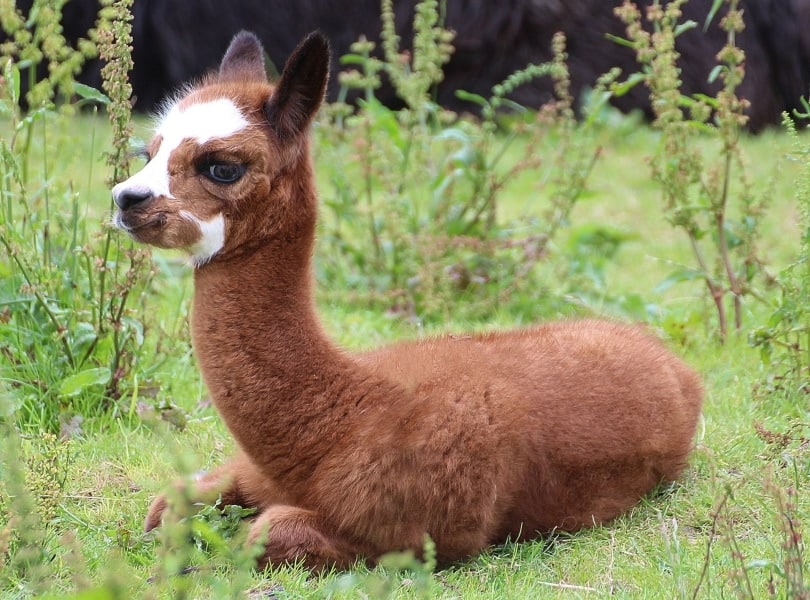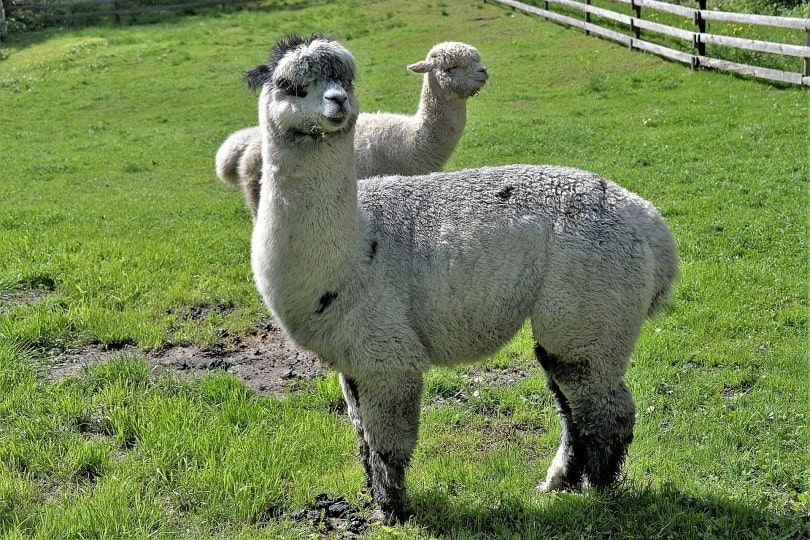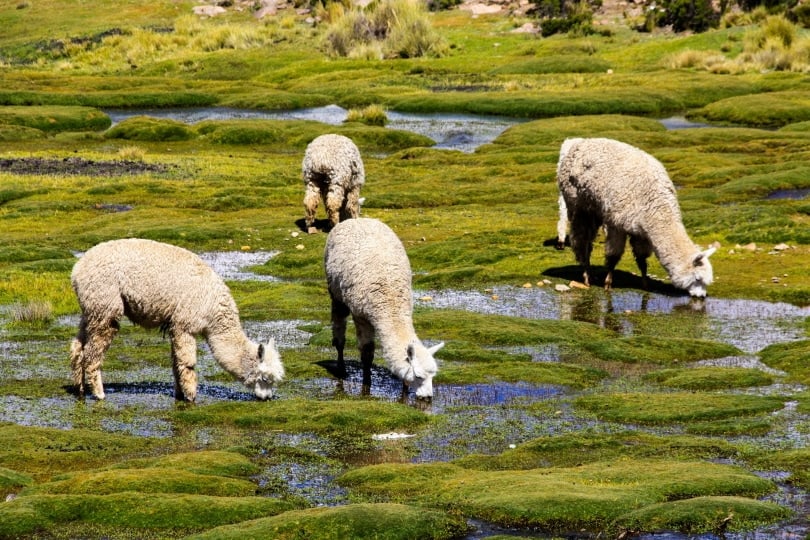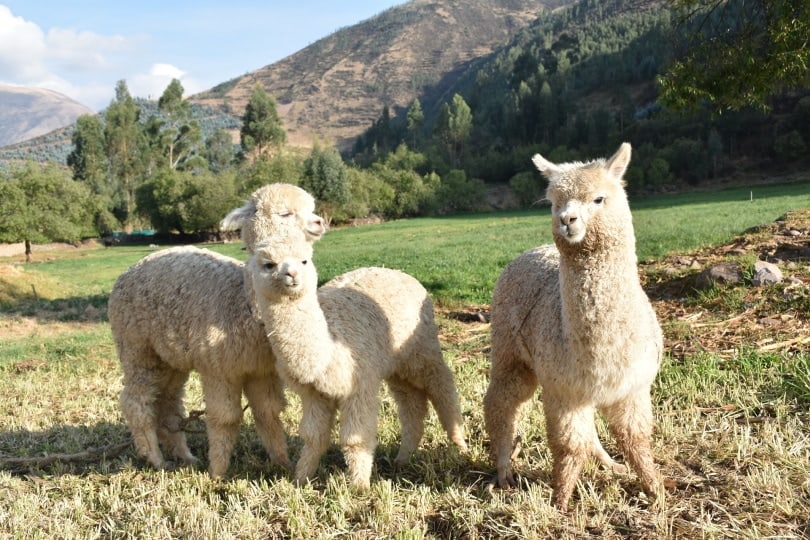Alpacas are increasingly popular exotic pets in the United States and can be a great choice if you have some land for them to roam around on. Alpacas play a big part in fleece production, and many farmers in America raise this for this reason. However, many inexperienced owners unsure what these exotic animals eat and if they would be able to provide them with a proper diet.
Alpacas are herbivores, meaning that they will only eat plant matter. If you are thinking of raising alpacas on your farm but want to know more about them first to see what they eat, keep reading while we discuss what they eat in the wild as well as in captivity so you can make an informed decision about if it’s right for you.

What Is an Alpaca?

Alpacas are a member of the camel family, and it’s closely related to the llama. Farmers likely domesticated it in the Andes mountains about 7,000 years ago. It lives in a small area of South America, and you will typically only find them in the hills from Columbia to Northern Chile. They have adapted to the marshy ground and are happiest at an altitude of 13,000 to 15,700 feet. It’s smaller than a llama and usually stands about 35 inches high at the shoulder and weighs a little over 120 pounds. It has a round body and keeps the tail close.
The thick, shaggy fur ranges in color and includes black, brown, grey, tan, yellow, and white. Most owners shear it about every two years for the maximum fur collection. The fur is lightweight, water-resistant, warm, and extremely soft. Peru is the leading producer of alpaca fur in the world.
What Do Alpacas Eat in the Wild?

Your alpaca is an herbivore, meaning that it will only eat plant matter when in captivity or in the wild though the exact plants it will eat will likely differ considerably. However, to be clear, there is some debate over whether there are any wild alpacas left since farmers domesticated them so long ago, and they are vital to the economy in that area. The Vicuna is its closest living relative and is similar but slightly smaller. These wild animals are grazers adapted to the high altitudes like the alpaca and are primarily grazers with a diet of short perennial grasses, and the wild alpaca likely ate something similar
What Do You Feed Captive Alpacas?

There are two types of alpaca, the Huacaya alpaca with a thick teddy bear-like coat and the Suri alpaca with thinner fur that most likely lives at lower altitudes. Both kinds will eat primarily grass and hay, which is easy to find and inexpensive if you need to purchase it. Many owners will also provide their alpacas with commercial pellets to ensure they get the proper vitamins and minerals required to stay healthy. There is also commercial food available if you don’t have access to land they can graze on to provide a complete and balanced meal. If you have access to land, pasture grass will usually provide the required protein, while hay, leaves, and stems will give it the fiber it needs for a stable digestive system. Green grass and supplements will provide the required vitamin A and E.
Your alpaca will have a much more varied diet in the summer months while plants are growing, but during the winter, they will only have hay will make up the majority of the diet because it helps to keep them warm, so it’s important to make sure they et the required supplements during this time.
How Much Does an Alpaca Eat?

Most farmers recommend feeding your alpaca about 1.5% of its body weight in food each day. So, if you have a 100-pound alpaca, you will need to provide it 1.5 pounds of hay or pasture grass plus supplements. However, if you are feeding commercial food, we recommend following the directions on the package because it may contain ingredients that cause you to feed a different amount than usual. If your alpaca is pregnant, you will need to increase the food supply to 2.5% of the animal’s weight for the duration of the pregnancy.
Alpaca Teeth
As can be expected, the alpaca has teeth especially suited for the cutting and grinding of plant matter. Incisors cut and chop the plants while molars grind the food down. Males can even have a set of fighting teeth that resemble canine teeth to protect themselves. However, like some other grazing animals, like rabbits, the teeth of the alpaca keep growing and can make it difficult for the animal to eat, so most experts recommend trimming the teeth every year to avoid problems that can occur.
How Much Water Do Alpacas Need?

Since the alpaca is related to the camel, many people wonder if they can store water the same way. Unfortunately, the alpaca is not a desert animal and will need quite a bit of freshwater each day to stay hydrated. Most experts recommend at least five liters every day, a little over 1.25 gallons for us Americans. Automatic water dispensers are the best because it helps keep the water fresh which will reduce stress and help keep your alpaca happy.
Can Alpacas Eat Fruits and Vegetables?
Yes, you can feed your alpaca small amounts of fruits and vegetables if you chop them up small and they enjoy them. Alpacas are usually fond of carrots, lettuce, celery, cabbage, and pineapple. Most fruits will have too much sugar for your alpaca, so you’ll need to make them a rare treat. Some vegetables, like carrots, also contain a lot of sugar, so we recommend checking the nutritional data for any fruits or vegetables before feeding them and choosing ones with less sugar.

Final Thoughts
Alpacas make great exotic pets, and you can also keep them for their fur, so they can be quite profitable. Their diet is not hard to maintain, and they will primarily eat hay and forage grasses like other herbivores you might already have, like the horse, cow, and sheep. Commercial alpaca pellets are not too expensive and will make sure it gets enough vitamins and minerals to keep it strong and healthy.
We hope you have enjoyed reading over our look into these interesting animals, and it has answered your questions. If we have helped you provide a healthier diet for your flock, please share this guide to what alpacas eat with your friends.
- Related Read: Name Ideas For Cute & Funny Alpacas
Featured Image Credit by: Götz Friedrich, Pixabay
